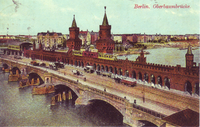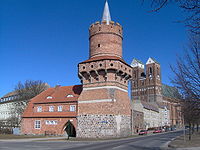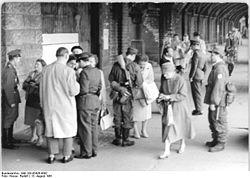- Oberbaum Bridge
-
The Oberbaum Bridge (German: Oberbaumbrücke) is a double-deck bridge crossing Berlin's River Spree, considered one of the city landmarks. It links Friedrichshain and Kreuzberg, former boroughs that were divided by the Berlin Wall, and has become an important symbol of Berlin’s unity.
The lower deck of the bridge carries a roadway, which connects Oberbaum Straße to the south of the river with Warschauer Straße to the north. The upper deck of the bridge carries Berlin U-Bahn line U1, between Schlesisches Tor and Warschauer Straße stations.
The bridge appears prominently in the 1998 film Run Lola Run.
Contents
History
The bridge is built on the former boundary of the municipal area with its rural environs, where an excise wall was built in 1732. A wooden drawbridge was built as part of the wall; it served as a gate to the city. The name Oberbaumbrücke stemmed from the heavy tree trunk, covered in metal spikes, that was used as a boom to block the river at night to prevent smuggling. (Baum means tree or wooden beam in German; thus the name means something like "Upper [Upstream] Tree Bridge"; there was another tree-trunk barrier at the western end of the contemporary city limits, close to today's Unterbaumstraße (lit. in English: Lower [Downstream] Tree Street.)
By 1879 the wooden bridge had been modified greatly. At 154 meters it was Berlin's longest, but was no longer adequate to the amount of traffic crossing it. Plans began to be drawn up for a new stone construction. The Siemens & Halske company, which was planning to build the Berlin U-Bahn (subway), insisted on a combined crossing for road vehicles, pedestrians, and the new rail line. The new bridge opened in 1896 after two years of construction, in time for the Berlin Trades Exhibition. The architect and government official Otto Stahn (1859-1930) designed it in North German Brick Gothic, in the style of a city gate with many decorative elements, such as pointed arches, cross vaults, and coats of arms. The two towers were inspired by the Middle Gate Tower (Mitteltorturm) in the northern Brandenburg city of Prenzlau. Although purely cosmetic, they served as a reminder that the site was once Berlin’s river gateway.
In 1902 the first segment of the U-Bahn opened. Its inaugural journey, carrying 19 passengers, ran from Stralauer Thor, at the eastern end of the bridge, to Potsdamer Platz. Stralauer Thor was dismantled after being damaged in a 1945 air raid, but its four sandstone-clad support posts can still be seen.
After Berlin absorbed several other municipalities in 1920, the Oberbaum Bridge became the crossing between the new boroughs of Friedrichshain and Kreuzberg. In April 1945 the Wehrmacht blew up the middle section of the bridge in an attempt to stop the Red Army from crossing it. After the war ended, Berlin was divided into four sectors. The Oberbaum Bridge crossed between the American and Soviet sectors. Until the mid-1950s, pedestrians, motor vehicles, and the city tramway were able to cross the bridge without difficulty.
Border crossing
When the Berlin Wall was built in 1961 the bridge became part of East Berlin's border with West Berlin; as all the waters of the River Spree were in Friedrichshain, the East German fortifications extended to the shoreline on the Kreuzberg side. The West Berlin U-Bahn line was forced to terminate at Schlesisches Tor. Beginning on 21 December 1963, the Oberbaum Bridge was used as a pedestrian border crossing for West Berlin residents only.
After the opening of the Wall in 1989, and German reunification the following year, the bridge was restored to its former appearance, albeit with a new steel middle section designed by the Spanish architect Santiago Calatrava. It opened to pedestrians and traffic on 9 November 1994, the fifth anniversary of the opening of the Berlin Wall. The U-Bahn line to Warschauer Straße station was reopened a year later.
Since 1997, a neon installation entitled "Stone - Paper - Scissors" by Thorsten Goldberg has adorned the bridge. Its two elements are engaged in a constant game of rock, paper, scissors, suggesting the arbitrariness of immigration decisions, both during the Cold War and for today's asylum seekers and poverty migrants.
Since 1999, the traditional rivalry between the traditionally left-leaning boroughs Kreuzberg and Friedrichshain is played out in the annual "water battle", where residents from both areas, organized in groups with satirical names such as "Anarcho-Cynical Offensive Berlin - Friedrichshain Faction" or "Kreuzberg Landwehr" pelt each other with rotten vegetables, jello, eggs, flour and water and try to symbolically "reconquer" the "renegade" other borough (Friedrichshain being mockingly referred to as "East Kreuzberg" and Kreuzberg as "Lower Friedrichshain") by driving their participants from the bridge. Due to their higher turnout and the superior "armament" (including home-built water cannons), the Friedrichshain detachments have won the water battle on a regular basis.
With the creation of the unified Friedrichshain-Kreuzberg borough in 2001, the Oberbaum Bridge no longer crosses a jurisdictional boundary.
See also
References
External links
Coordinates: 52°30′07″N 13°26′44″E / 52.50194°N 13.44556°E
Categories:- History of Berlin
- Road-rail bridges
- Bridges completed in 1896
- Berlin border crossings
- Bridges in Berlin
- Buildings and structures in Friedrichshain-Kreuzberg
- Road bridges in Germany
- Railway bridges in Germany
Wikimedia Foundation. 2010.





